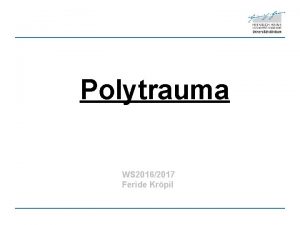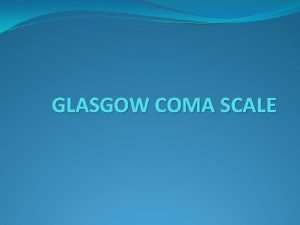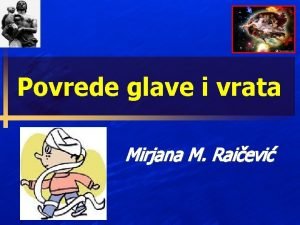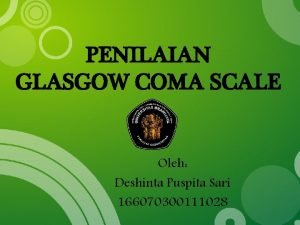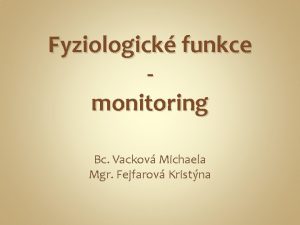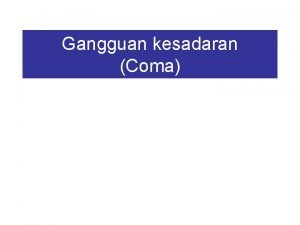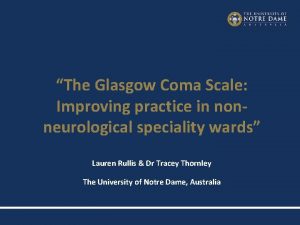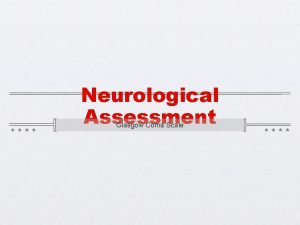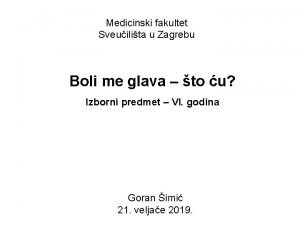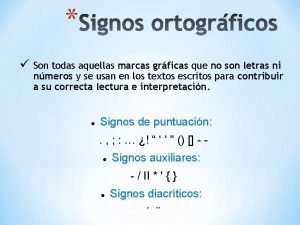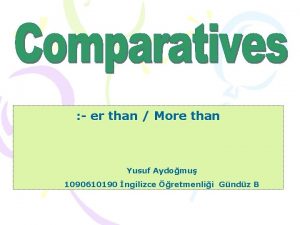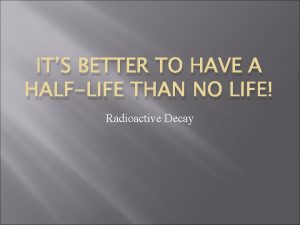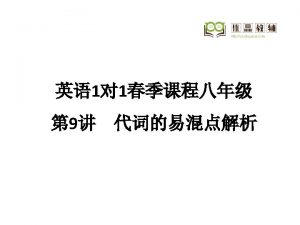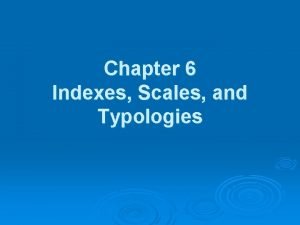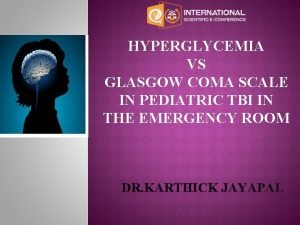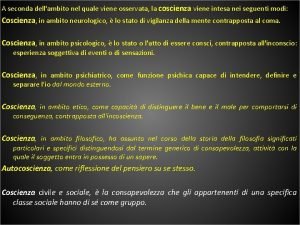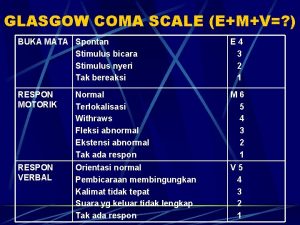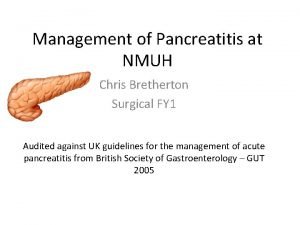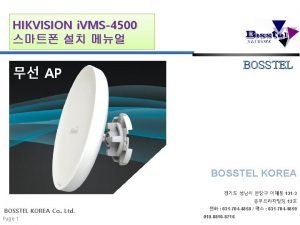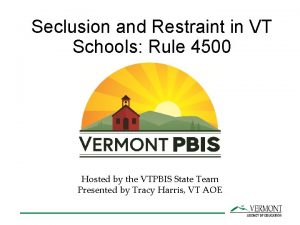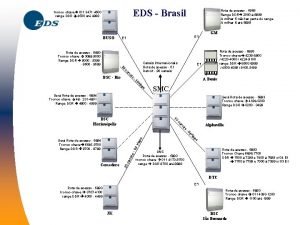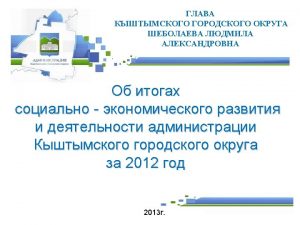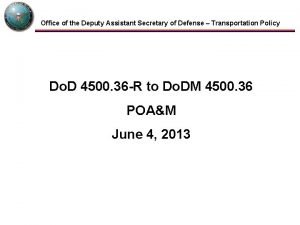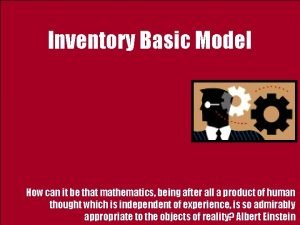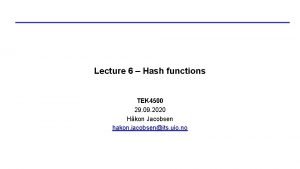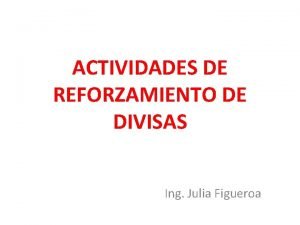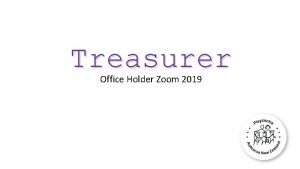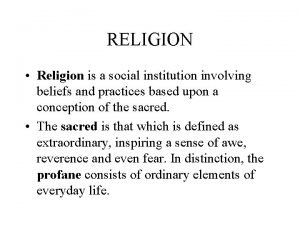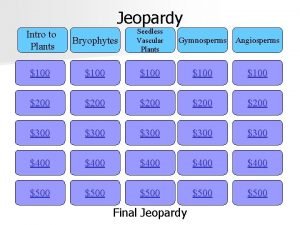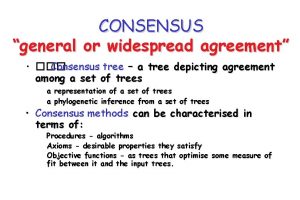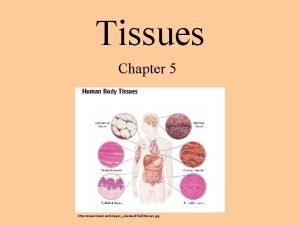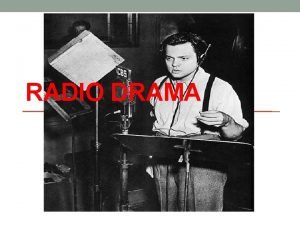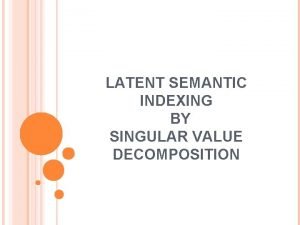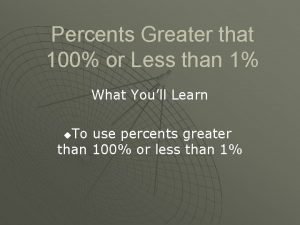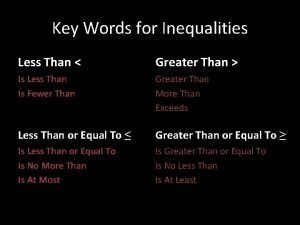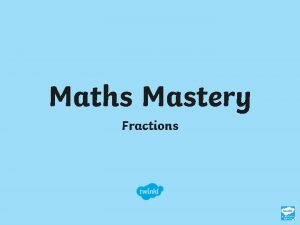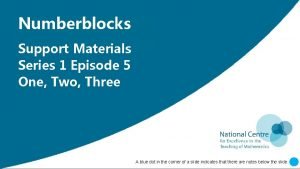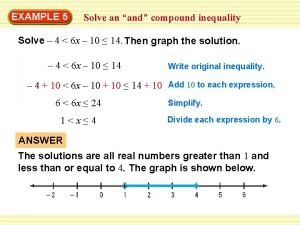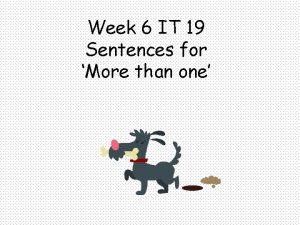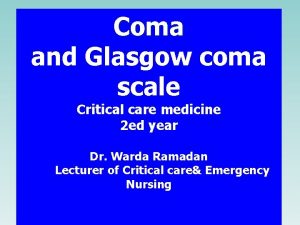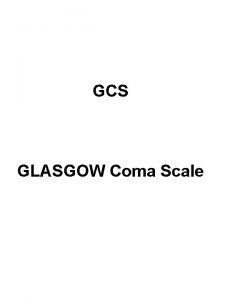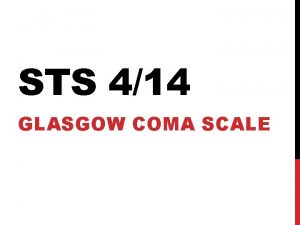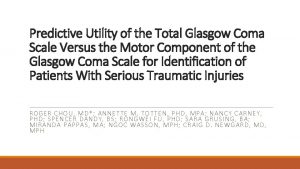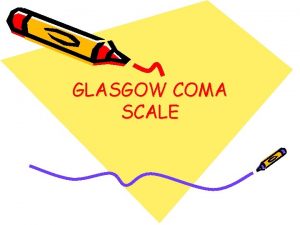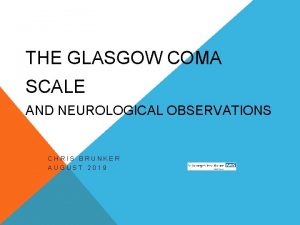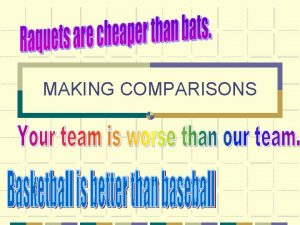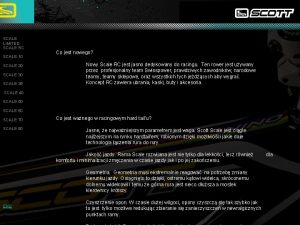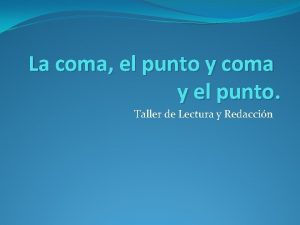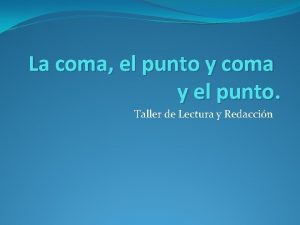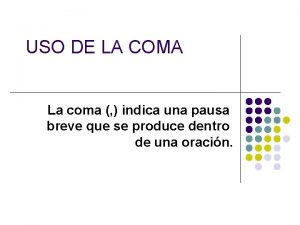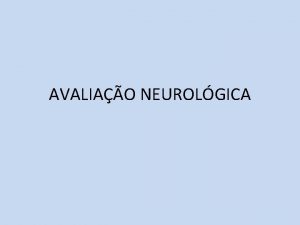GLASGOW COMA SCALE WIDESPREAD USE More than 4500














































- Slides: 46

GLASGOW COMA SCALE

WIDESPREAD USE �More than 4500 publications have appeared to its use (MEDLINE search performed in October 2005) �Component of �APACHE II Acute Physiology and Chronic Health Evaluation score �RTS Revised Trauma Score, �TRISS Trauma and Injury Severity Score �CRAMS The Circulation, Respiration, Abdomen, Motor, Speech Scale

NEED Developed primarily to facilitate the �assessment and �recording of initial severity of brain dysfunction and of �ultimate outcome in a multicenter study of outcome after severe brain damage.

�Aim was to use �Simple terms that could be �Readily understood by a wide range of �Observers Doctors Nurses Others.

�Repeated observations of the coma scale displayed on a bedside chart give it a second use �Monitoring of improvement or deterioration in conscious level as an indication of recovery or of complications.

HISTORY �Early in World War II Medical Research Council(MRC) , Britain issued Glossary of 16 psychological terms commonly used in cases of head injury that included �Coma �Semicoma, �Confusion - mild, moderate and severe �Stupor �Automatism.

�Post-war neurosurgical practice was much more concerned with elective surgery for tumors and aneurysms �Fatalistic attitude to head injuries believing little could be done to affect the outcome.

�Good resuscitation and intensive care saved many severely head injured patients �Neurosurgeons were challenged to Assist in reducing mortality Save as much of the damaged brain as possible

�Studies in Glasgow revealed Much of the mortality and persisting disability after head injury was potentially avoidable, �As reflected in the title of one paper ‘Head injuries who talk and die’* * Reilly PL, Adams JH, Graham DI, et al: Patients with head injury who talk and die. Lancet 2: 375 -377, 1975

�Implication If they had talked they had not suffered irreversible damage and should not have died. �Failure to detect complications early enough led to many avoidable deaths.

�GREATEST CONCERN ? �Surgeons/Intensivists �How to predict who was worth treating

1970 Glasgow Teasdale and Jennett

�Set up studies of Severe head injury with collaborators in the Netherlands and the USA. * �Later extended To include monitoring of early severity and outcome of coma from Non-traumatic brain insults. � Jennett B, Teasdale G, Galbraith S, et al: Severe head injuries in three countries. J Neurol Neurosurg Psychiat 40: 291 -298, 1977

�Comparisons needed between groups of patients whose initial injuries were of similar (but varying) severity, and their outcome. �Data collection and analysis involved computers the task was to translate clinical descriptions to numerical form.

�Teasdale and Jennett published the Glasgow Coma Scale (GCS) in the Lancet in 1974 as an aid in the clinical assessment of posttraumatic unconsciousness.

Glasgow coma scale BEHAVIOUR RESPONSE SCORE Best Eye Response Spontaneously To speech To pain No response 4 3 2 1 Best Verbal Response Oriented to time, place, person Confused Inappropriate words Inappropriate sounds No response 5 4 3 2 1 Best Motor Response Obeys commands Moves to localized pain Flexion withdrawal from pain Abnormal flexion(decorticate) Abnormal extension(decerebrate) No response 6 5 4 3 2 1 Total Score Best response Comatose client Totally unresponsive 15 8 or less 3 16

�Higher scores indicate a better prognosis (Fani-Salek et al. , 1999). �Singounas (1995) proposed the addition of the score 2 brain death score -1 absence of brainstem reflexes.

�Initial score assigned six hours after HT* had been sustained To avoid overestimation of brain damage produced by transient factors, such as �hypoxia, �hypotension or �alcohol intoxication �GCS score should be recorded before sedation *(Marion, Carlier, 1994 ; Jennett, Teasdale, 1977

BEST EYE RESPONSE �Spontaneous (4) �To speech (3) �To pain (2) � None (1) � is indicative of activity of brainstem arousal mechanisms but not necessarily of attentiveness � tested by any verbal approach (spoken or shouted). � tested by a stimulus in the limbs (supraorbital pressure may cause grimacing and eye closure). � no response to speech or pain.

BEST VERBAL RESPONSE �Oriented (5) �Confused (4) �Inappropriate words (3) �Incomprehensible sounds (2) �None (1) � awareness of the self and the environment (who / where / when) � responses to questions with presence of disorientation and confusion � speech in a random way, no conversational exchange � moaning, groaning � no response.

BEST MOTOR RESPONSE �Obeying commands (6) �Localizing (5) �Normal flexor response (4) �Abnormal flexor response (3) � the rater must rule out grasp reflex or postural adjustment � movement of limb as to attempt to remove the stimulus, the arm crosses midline � rapid withdrawal and abduction of shoulder � adduction of upper extremities, flexion of arms, wrists and fingers, extension and internal rotation of lower extremities, plantar flexion of feet, and assumption of a hemiplegic or decorticate posture.

BEST MOTOR RESPONSE �Extensor posturing (2) � adduction and hyperpronation of upper extremities, extension of legs, plantar flexion of feet, progress to opisthotonus (decerebration). �None (1) � the observer must rule out an inadequate stimulus or spinal transection

�Peripheral stimuli may elicit a spinal reflex response, �Pressure on the sternum or the supraorbital ridge may cause injury to the patient

� Score of 3 lesion - internal capsule or cerebral hemispheres (Harrahill, 1996) Disinhibition by removal of corticospinal pathways above the midbrain (Greenberg, 2001). � Score of 2 Lesion - midbrain to upper pontine (Iacono, Lyons, 2005 ; Heim et al. , 2004) Disinhibition of vestibulospinal tract and pontine reticular formation by removing inhibition of medullary reticular formation transection at intercollicular level between vestibular and red nuclei (Greenberg, 2001). ones, 1979).

APPLICATIONS �The use of standardized scales aids in evaluating different studies and trials (Ko, 2002). �The GCS describes and assesses coma, monitors changes in coma, is an indicator of severity of illness, facilitates information transfer, and is used as a triage tool in patients with HT (Heim et al. , 2004 ; Bion, 1997)

�Aids in clinical decisions � Intubation (for total GCS score <= 8 or motor score <= 4) �Monitoring of intracranial pressure (ICP) : 1) GCS score of 3 -8 (severe TBI) with abnormal CT-all patients with normal CT - if age >40 yrs u/l, b/l motor posturing SBP < 90 mm. Hg

� 2)GCS >8 If require prolonged anesthesia / pharmacologic paralysis If require treatment that might raise ICP high PEEP.

�Essence of GCS Independent assessment of graded responses in three behavioural domains eye opening (E), motor response (M) and verbal activity(V). If one type of response is untestable, for example due to periorbital swelling or endotracheal intubation, the others are still available

�CLASSIFICATION OF SEVERITY OF HT (Ko, 2002) A score of � 13 -15 - minor, � 9 -12 - moderate � 5 -8 - severe � 3 -4 -very severe injury �Other studies report three GCS score intervals (Sternbach, 2000). � 13 -15 -mild HT � 9 -12 -moderate HT �< 8 -severe HT

�Stein (1996) proposed five intervals �(a) minimal (15, with no LOC or amnesia) �(b) mild (14 -15 plus amnesia or LOC for < 5 minutes or impaired alertness or memory) �(c) moderate (9 -13 or LOC ≥ 5 minutes or focal neurological deficit) �(d) severe (5 -8) �(e) critical (3 -4).

SHORTCOMINGS OF GCS �Linearity �Numerically skewed toward motor responses �Because there are only four units assigned to the eye responses, versus five to the verbal and six to the motor responses, the scale incorporates a numerical skew toward motor response.

SHORTCOMINGS OF GCS �Reliability �No assessment of brainstem reflexes (eye movements, complex motor responses)

SHORTCOMINGS OF GCS �May not detect subtle changes �Verbal component-Intubation �Summing GCS components has also been criticized on a purely mathematical basis

IDEAL COMA SCALE �Reliable (measures what it is supposed to measure) �Valid (yields the same results with repeated testing) �Linear (gives all component equal weight) �Easy to use (provides simple instructions without the need for tools or cards)

FOUR Score Full Outline of Un Responsiveness

FOUR Score �Measurement of brainstem reflexes �Determination of eye opening, blinking and tracking �A broad spectrum of motor responses �Presence of abnormal breath rhythms and a respiratory drive �No assessment of verbal responses (intubation)

�The FOUR score recognizes �Locked-in syndrome and a possible vegetative state. �Signs suggesting uncal herniation. �Respiratory patterns need for respiratory support in stuporous or comatose patients, presence of a respiratory drive.

Outcome assessment : Good predictor of �In-hospital mortality �Functional outcome at hospital discharge �Clinical diagnosis of brain death �Morbidity at 3 months

�The FOUR score �Further characterizes the severity of the comatose state in patients with the lowest GCS score. �Probability of in-hospital mortality was higher for the lowest total FOUR scores when compared with the GCS

FOUR - PROS High degree of �Internal consistency �Interrater reliability (interobserver agreement) Not affected by �Intubation status of patients

Incorporates �Brainstem reflexes �Respiratory patterns

�Detects early changes in consciousness(Acute metabolic derangements, sepsis, shock, other nonstructural brain injuries) �Frequent use of mild sedation affects: Eye opening Motor response �NOT: Brainstem reflexes Respiration.

REVIEW OF LITERATURE � A mathematical analysis of this pruned scale shows a predominant skew towards the motor response � � � The Glasgow Coma Scale: a mathematical critique. Bhatty GB, Kapoor N. Source R. M. L. Hospital, New Delhi, India. Abstract The Glasgow Coma Scale permits 120 possible mathematical combinations of eye, verbal and motor scores. Out of these only about 15 are clinically valid and useful in the assessment of altered consciousness. A mathematical analysis of this pruned scale shows a predominant skew towards the motor response. Without clinically altering the scale. The numerical values can be modified to produce a more equitable dominance by each of the factors and greater precision. This is also necessary as the value of a unit is the same in the sum score, whether contributed by the eye, verbal or motor elements. PMID: 8460564 [Pub. Med - indexed for MEDLINE]

� The present study demonstrates that a relatively simple regression model can use the eye and motor components of the GCS to predict the expected verbal component of the GCS, thus allowing the calculation of the GCS sum score in intubated patients. � � � Appropriate use of the Glasgow Coma Scale in intubated patients: a linear regression prediction of the Glasgow verbal score from the Glasgow eye and motor scores. Rutledge R, Lentz CW, Fakhry S, Hunt J. Source Department of Surgery, University of North Carolina at Chapel Hill 27599 -7210, USA. Abstract The Glasgow Coma Scale (GCS) has been shown to be a valuable tool in assessing the neurologic and physiologic status of critically ill patients. Unfortunately, the GCS requires assessment of the verbal response of the patient and this can be blocked by intubation. The purpose of this study was to assess the ability of a regression model based upon the eye and motor components of the GCS to accurately predict the verbal response of the GCS. The primary hypothesis was that the verbal response could be derived from the motor and eye responses of the GCS. METHODS: Data were collected prospectively in an intensive care unit computer data base. Patients were divided into training and test data sets. Linear regression was used to derive a model of verbal score from the motor and eye scores of the GCS in the training data set. Correlation between the actual and the predicted verbal scores was calculated. RESULTS: A total of 2, 521 GCS assessments were available for analysis. The second order multiple regression model was an accurate predictor of the verbal score (Pearson's Correlation r = 0. 9, R 2 = 0. 8, p = 0. 0001) in 1, 463 observations in the training data set. Second Order Multiple Regression Model: Estimated GCS Verbal = (2. 3976) + [GCS Motor x (-0. 9253)] + [GCS Eye x (-0. 9214)] + [(GCS Motor)2 x (0. 2208)] + [(GCS Eye)2 x (0. 2318)] where r = 0. 91, R 2 = 0. 83, and p = 0. 0001. The accuracy of this model was confirmed by comparing the predicted verbal score to the actual verbal score in the test data set (n = 736, r = 0. 92, R 2 = 0. 85, p = 0. 0001) CONCLUSIONS: The GCS is a useful tool in the intensive care unit and a critical part of the APACHE II assessment of patient acuity. GCS has been shown to be a useful tool in its own right as a predictor of outcome in the critically ill. Its use is limited with intubation. (See Segatore M, Way C: Heart Lung 21: 548, 1992; and Lieh-Lai MW, Theodorou AA, Sarnaik AP, et al: J Pediatr 120: 195, 1992. ) The present study demonstrates that a relatively simple regression model can use the eye and motor components of the GCS to predict the expected verbal component of the GCS, thus allowing the calculation of the GCS sum score in intubated patients.

` � Because the m component is nonlinear in the log odds of survival, however, it should be mathematically transformed before its inclusion in broader outcome prediction models. � � � Improving the Glasgow Coma Scale score: motor score alone is a better predictor. Healey C, Osler TM, Rogers FB, Healey MA, Glance LG, Kilgo PD, Shackford SR, Meredith JW. Source Department of Surgery, University of Vermont, College of Medicine, Burlington 05401, USA. Abstract BACKGROUND: The Glasgow Coma Scale (GCS) has served as an assessment tool in head trauma and as a measure of physiologic derangement in outcome models (e. g. , TRISS and Acute Physiology and Chronic Health Evaluation), but it has not been rigorously examined as a predictor of outcome. METHODS: Using a large trauma data set (National Trauma Data Bank, N = 204, 181), we compared the predictive power (pseudo R 2, receiver operating characteristic [ROC]) and calibration of the GCS to its components. RESULTS: The GCS is actually a collection of 120 different combinations of its 3 predictors grouped into 12 different scores by simple addition (motor [m] + verbal [v] + eye [e] = GCS score). Problematically, different combinations summing to a single GCS score may actually have very different mortalities. For example, the GCS score of 4 can represent any of three mve combinations: 2/1/1 (survival = 0. 52), 1/2/1 (survival = 0. 73), or 1/1/2 (survival = 0. 81). In addition, the relationship between GCS score and survival is not linear, and furthermore, a logistic model based on GCS score is poorly calibrated even after fractional polynomial transformation. The m component of the GCS, by contrast, is not only linearly related to survival, but preserves almost all the predictive power of the GCS (ROC(GCS) = 0. 89, ROC(m) = 0. 87; pseudo R 2(GCS) = 0. 42, pseudo R 2(m) = 0. 40) and has a better calibrated logistic model. CONCLUSION: Because the motor component of the GCS contains virtually all the information of the GCS itself, can be measured in intubated patients, and is much better behaved statistically than the GCS, we believe that the motor component of the GCS should replace the GCS in outcome prediction models. Because the m component is nonlinear in the log odds of survival, however, it should be mathematically transformed before its inclusion in broader outcome prediction models.

THANK YOU
 Lirik lagu more more more we praise you
Lirik lagu more more more we praise you More more more i want more more more more we praise you
More more more i want more more more more we praise you Glasgow coma scale 15 punkte
Glasgow coma scale 15 punkte Gcs score
Gcs score Trapezium squeeze
Trapezium squeeze Observacija
Observacija Glasgow coma scale interpretasi
Glasgow coma scale interpretasi Glasgow coma scale
Glasgow coma scale Gcs
Gcs Tingkat kesadaran gcs
Tingkat kesadaran gcs Gcs
Gcs Glasgow coma scale video
Glasgow coma scale video Glavobolja na vrhu glave
Glavobolja na vrhu glave Oraciones coordinadas
Oraciones coordinadas Generous kelimesinin comparative hali
Generous kelimesinin comparative hali 5730x5
5730x5 Better than god
Better than god Scale scores convey more information than index scores.
Scale scores convey more information than index scores. Pediatric coma scale adalah
Pediatric coma scale adalah Mioclonie
Mioclonie Gcs e m v
Gcs e m v Glasgow scale pancreatitis
Glasgow scale pancreatitis Monitor de siembra controlagro
Monitor de siembra controlagro Ibm ts4500 tape library
Ibm ts4500 tape library Vms4500
Vms4500 Rule 4500
Rule 4500 Ddr-4500+
Ddr-4500+ 14000-4500
14000-4500 4500/36
4500/36 Most inventory models attempt to minimize
Most inventory models attempt to minimize Tek4500
Tek4500 4500 yenes a soles
4500 yenes a soles May peace be widespread karakia
May peace be widespread karakia Is religion a social institution
Is religion a social institution A popular seedless vascular plant is _____.
A popular seedless vascular plant is _____. Widespread consensus
Widespread consensus Most widespread tissue in the body
Most widespread tissue in the body What decade did radio drama achieve widespread popularity?
What decade did radio drama achieve widespread popularity? Occurances synonym
Occurances synonym Percents greater than 100 and less than 1
Percents greater than 100 and less than 1 Fractions greater less than or equal to
Fractions greater less than or equal to Less than key words
Less than key words Fraction odd one out
Fraction odd one out Jesus lord of heaven
Jesus lord of heaven Numberblocks 10
Numberblocks 10 Compound inequality examples
Compound inequality examples Climb sentence
Climb sentence


